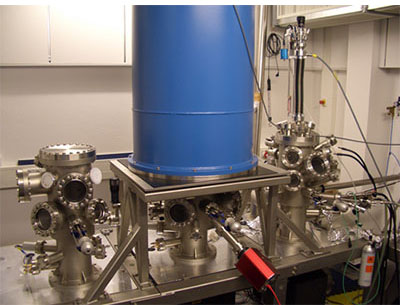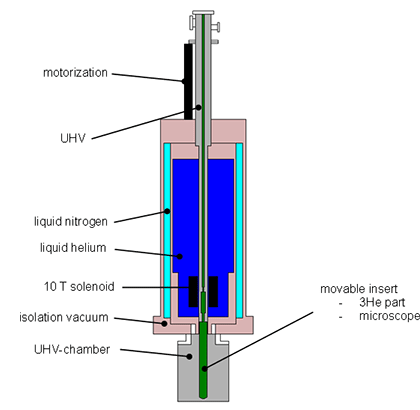300 mK-10 T-UHV-AFM system
Currently we are setting up a system for measurements with atomic force microscopy (AFM) (fig.), especially for magnetic exchange force microscopy and spectroscopy (MExFM, MExFS). The base pressure of the system is better than 10-10 mbar (ultra-high vacuum, UHV) in order to maintain very clean surfaces for several days after an in-situ sample preparation. Furthermore, temperatures as low as 0,3 Kelvin (-272,8 °C) can be reached with a considerable effort compared to conventional He-4 bath cryostats (T > -268,9 °C), but it is paid off by a higher stability in terms of thermal drift which is important for long term experiments. Also, the energy resolution, scaling with  , is improved allowing a better resolution in spectroscopic and dissipation measurements. Translation and thermal spin switching especially of isolated atoms and molecules deposited on surfaces is inhibited at lower temperatures which is a prerequisite for magnetic sensitive measurements of such species. The ability to apply a magnetic field up to 10 Tesla in the system is important to influence the magnetism of our sensor and the sample and do field dependent measurements.
, is improved allowing a better resolution in spectroscopic and dissipation measurements. Translation and thermal spin switching especially of isolated atoms and molecules deposited on surfaces is inhibited at lower temperatures which is a prerequisite for magnetic sensitive measurements of such species. The ability to apply a magnetic field up to 10 Tesla in the system is important to influence the magnetism of our sensor and the sample and do field dependent measurements.
The concept of the whole UHV-system considers the ease of use and efficiency as well as vibrational aspects due to the symmetric setup and the limited lab space. It consists of three UHV chambers aligned in a row and an additional load lock for introducing tip and samples into the UHV equipped with a tool for cleaving crystals. Various tip and sample preparation steps such as ion bombardment, heating with e-beam and resistance devices as well as evaporation of metal and organic species can be carried out in the preparation chamber. For a first analysis of the sample preparation a LEED/Auger device (low energy electron diffraction; Auger electron spectroscopy) is mounted to the analysis chamber. The third chamber in the centre is needed for tip and sample exchange to the microscope. Since there is no access to the microscope in the measurement position, it has to be moved downwards into the cryostat chamber. Evaporation of single metal atoms and organic molecules directly onto a cold substrate placed inside the microscope is also possible.
The cryostat is placed on top of and connected to the cryostat chamber. The microscope can be moved inside a UHV tube located in the center of the cryostat. The UHV tube is surrounded by the liquid helium tank which also contains the superconducting single solenoid magnet with an inner bore 90 mm. For measurements the microscope is positioned in the 10 T magnet. For thermal isolation the liquid helium tank is surrounded by a liquid nitrogen tank. The centerpiece of the cryostat is the He-3 evaporation refrigerator to which the microscope is connected. It makes use of the fact that the rare Helium isotope He-3 gets superfluid at much lower temperatures compared to He-4. Due to this phenomenon it is not possible to cool down He-4 to such low temperatures.The cooling process from 4,2 to 0,3 K is as follows: At the beginning all He-3 is stored in a so called sorption pump inside the cryostat, which contains mainly charcoal. The He-3 can be released from this pump by heating it to about 40 to 50 K. At the same time a small He-4 reservoir nearby, which is continuously fed from the main bath, is pumped with a conventional rotary vane pump to reduce the gas pressure above the liquid. By this the temperature of the He-4 can be lowered from 4,2 K to about 1,6 K. Since the boiling point of He-3 is 3,2 K, it is enough to liquefy the bypassing He-3. After an amount of time most of the He-3 is condensed and the heating on the sorption pump is stopped. Its temperature drops and it starts to pump the He-3 at temperatures lower than 20 K with increasing efficiency. Since the He-3 does not get superfluid the temperature of the He-3 can be lowered to 0,3 K by pumping with the sorption pump. Continuous pumping on the small He-4 reservoir condenses some of the evaporated He-3 again, until finally all He-3 is stored in the sorption pump. This mode leads to long holding times at base temperature, but could also put some noise into the system due to the rotary vane pump. Hence, a second mode without pumping on the He-4 reservoir could be used which leads to approximately two-thirds shorter holding times. When the complete amount of He-3 was evaporated the process has to be started again.
The microscope follows the design of other home-built AFMs in our group and has a diameter of 36 mm only. It contains a fibre-optic interferometer for detection of the oscillation of a silicon cantilever. In contrast to existing setups the microscope body is made of metal (phosphorous bronze) instead of a ceramic to guarantee good thermal conductivity. All of its parts are accurately chosen for UHV-conditions and to resist such low temperatures and high magnetic fields. Special care was taken to adapt the thermal expansion coefficients of all used materials to reduce the stress inside the microscope when cooling to low temperatures. Provisions were taken to be able to implement an evaporator for organic materials directly into the microscope in the future.


